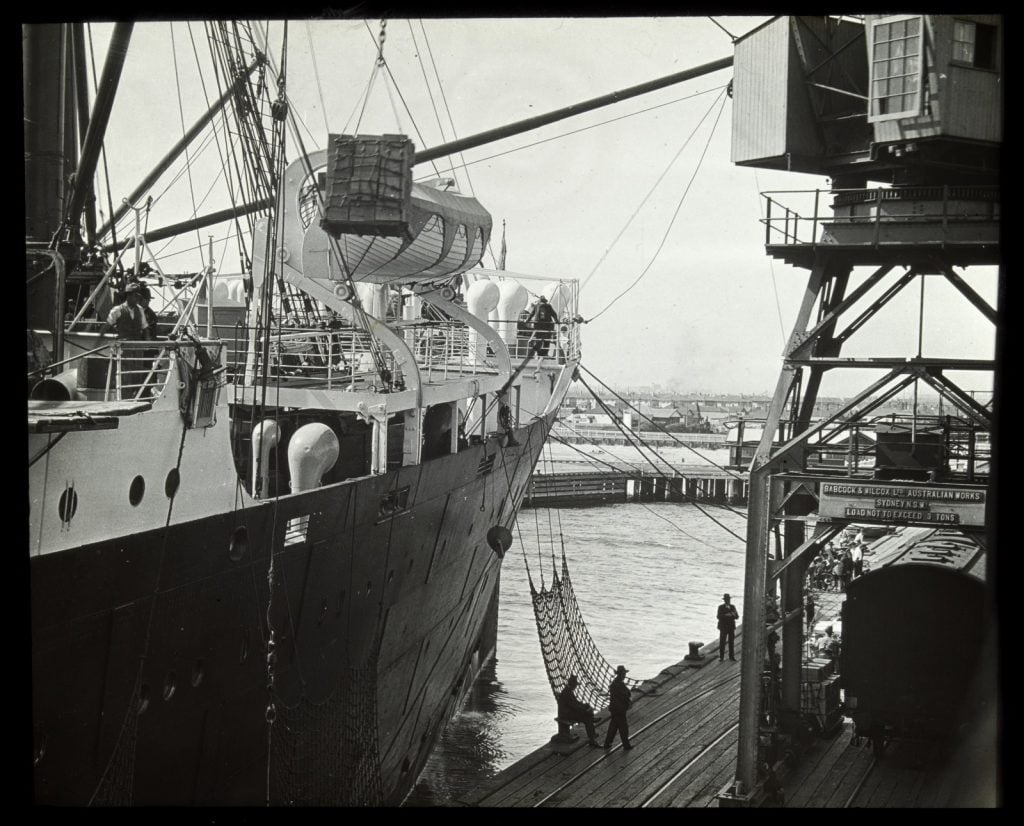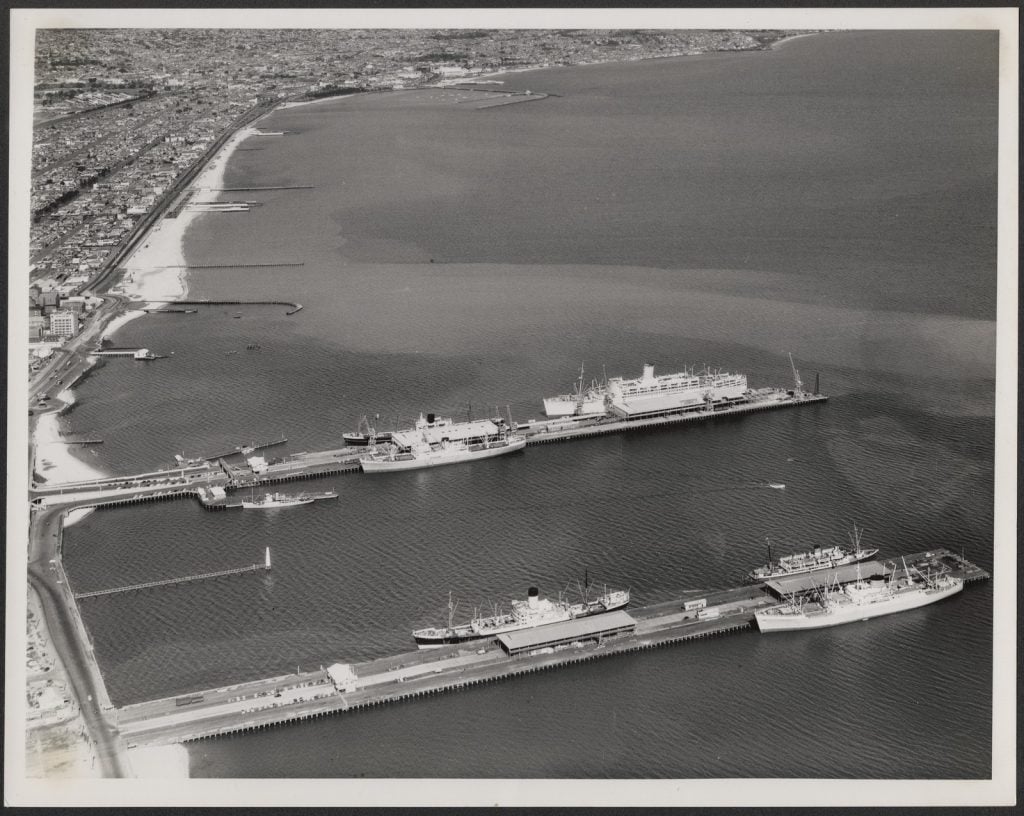With the dominance of air travel in the twenty-first century, it’s easy to forget what a massive role ships, ports and piers played in the development and history of Melbourne as a town and major Australian city.
The Port Phillip District was relatively unexplored by Europeans in the early nineteenth century; many of the earlier European settlers arrived from other parts of the Australian colony, including Van Diemen’s Land, looking for economic growth opportunities.
The discovery of gold in Victoria, in the early 1850s, led to the gold rushes, which saw hundreds of thousands of people coming from Great Britain, China and other countries, massively increasing passenger traffic at the Port of Melbourne pier.

Melbourne’s Station Pier, at Port Melbourne, opened in September 1854 – it was originally known as ‘Railway Pier’. It soon became the gateway for people arriving by sea, given that historically shipping was the main means of transportation for people coming from overseas.
Australia’s first railway line between the Station Pier and the Melbourne Terminus – which eventually became Flinders Street Station – also opened on that date, enabling transportation between the port and the Melbourne township. As the Port of Melbourne population grew, many settlers sought land further north and inland of the port, to establish market gardens, grow consumable products, and to herd cattle and sheep – for local consumption and export to interstate and overseas markets.1
With massively increasing use of the Railway Pier at the Port of Melbourne – more ships arrived bringing in people and transporting goods to-and-from Melbourne – it became necessary for the old pier to undergo multiple upgrades and extensions in order to accommodate the growing trade and traffic.
A new pier, built to the west of Railway Pier, was opened in 1916 and was called the New Railway Pier until 1921, when it was renamed Prince’s Pier.2
The current Station Pier, which replaced the Railway Pier, was built between 1922 and 1930.3

Station Pier and its antecedent, Railway Pier, played a major role in the evolution of Australia’s history beyond commerce. As such, the Pier holds special memories for many people to this day.

The Railway Pier was a major point of departure for troops off to fight in the Boer War in South Africa late in the nineteenth century. It was also the point of departure and return for many Australian volunteer troops who boarded ships to take them to fight in World Wars I & II. Many families, other supporters, and well-wishers would crowd the areas near the piers to farewell departing troops or greet any returning ones.

Station Pier also holds special memories for many immigrants to Australia. It was the point of arrival to Melbourne, from the mid-19th century onwards, but especially after World War II when European immigration numbers soared to Melbourne, through to the early 1970s when airplanes replaced shipping as a means of travel to Melbourne.

Today the berths on Station Pier are used either by cruise ships or other ships which need to replenish supplies or undertake works. The Pier is no longer open to the public.
References
- Davies, J 2008, Beyond the facade : Flinders Street, more than just a railway station, J. Davies, Mt Macedon, p6; Lee, R, 2007, The railways of Victoria 1854-2004, Melbourne University Publishing, Carlton
- Barnard, J and Jennings, S, 2004, Welcome & farewell : the story of Station Pier, Australian Scholarly Publishing, Melbourne, pp 58-59
- Barnard, J and Jennings, S, 2004, Welcome & farewell : the story of Station Pier, Australian Scholarly Publishing, Melbourne, pp.66-76


Thank you for this site. Station Pier has been woven throughout my family since the 1840’s. My grt grt grandmother arrived in Port Phillip in 1849. She was an Irish Orphan shipped over here after the potato famine by Earl Grey, the ship, the Pemberton had too deep a draught to sail all the way into the city so they had to disembark in Williamstown and walk until they met boats who paddled up to the Customs House. Her grandson in WW1 left and fought in France. Shipped off on the Wiltshire. He was wounded, recuperated at the Battle Hospital in Reading. Met a VAD nurse fell in love and after the war brought her and baby to Station Pier to start a new life in Melbourne.Their daughter met a British seaman during WW2 who had walked from his ship at Station Pier to St Kilda where she was showing her country cousin Luna Park. They got chatting and
he returned to Melbourne after the war, married and became an Australian citizen. His brother visited in a submarine after the war so we visited Station Pier, went aboard the submarine. I can remember looking through the periscope at Station Pier. Later I went with my parents on the Princess of Tasmania to Tasmania. My father the ex-seaman, would not go below but stayed on deck all night. He reminded me as we left Station Pier that it was the first time he’d been on a ship since the war. The memory of being torpedoed, of being in the sea after his ships were sunk, returned. He coped extremely well considering. We went to Station Pier to welcome his parents when they came out for a visit and again when we saw them off home.
Even the name evokes many memories and emotions that have been passed down over the years.
thank you Cheryl — it’s wonderful to read about histories of ‘family connections’ to the role of the Station Pier.
What a wonderful evocative memory passed down over your family.
I arrived as a 10-pound pom in 1976 on the Australis. just 21 married but not knowing anyone we were sent to the Enterprise hostel in Westall.
I now work at Station pier in the summer cruise season.
Thank you for your story
Memories of waving my grandmother off on her trips to England come to mind when seeing these photos etc. complete with the streamers being thrown.
29/06/2023
Thank you, Berta. A great contribution.
My parents and I arrived at Station Pier when the Sitmar Line’s ‘Castel Felice’ berthed on the south western side on the 21st March, 1961.
I recall the ship at anchor off Williamstown for a few hours before hand. It was a clear day and the passengers had a grand view of the city skyline. Except that the ship was experiencing a distinct list to one side. A PA announcement advised that ‘… Das Schiff ist listening too muchen to the seite und could eine half of die passagiere bitte pleasen go to die other seite …’
A swathe of said passagiere compliantly moved to die other seite – All 100 percent of them. Came another announcement shortly thereafter: ‘Das Schiff ist now listening too muchen to this seite und would eine half of die passagiere bitte again go-en to the other seite …’
As before, passengers obediently complied …. Funny that there were no further PA announcements re the ship’s stability, it berthing perfectly shortly after.
Berta,
A great article, thank you.
It highlights the roles played by Station Pier in Victoria’s (and Australia’s) history.
On a personal level, the last photo is of particular interest to me, as it shows the S.S Rip (ex-HMAS Whyalla) berthed at the West Wing of Station Pier, near the small lighthouse between Station and Prince’s piers. My late father served on the S.S.Rip, initially as the Second Engineer and then as her Chief Engineer in the 1950’s & early 1960’s.This ship belonged to the Ports & Harbors, part of the former Public Works Department. She is now preserved in Whyalla, where she was built in World War Two for the RAN, in recognition of the ship’s history & the now defunct BHP shipbuilding industry in Whyalla.
Thank you Derek especially for the historical information regarding the ship’s history as well as the family history. It’s been very interesting to see what this blog has initiated in terms of peoples’ family histories. Thanks again 🙂
A good report, well presented.
Thank you Berta
I too have generations of connection with these piers. My maternal grandfather and 5 uncles were all “ wharfies” on the piers. When I was a child ( 1950s onwards) my family lived in Port Melbourne and we kids regularly roamed the piers. I especially loved being there when ships were leaving for England and streamers were thrown down to remaining relatives until they broke as the ship moved away. We kids would collect the remnants. I would wind them up and use them for years as Christmas decorations. Such was life for poor kids.
The Melbourne Maritime Heritage Network (MMHN) congratulates the SLV . Station Pier is of immense historic value to Melbourne – social, cultural and economic.A major MMHN Objective is Re-imagining Station Pie. See the MMHN website http://www.mmh.org.au
MMHN staunchly advocates that all relevant government departments and agencies recognise the significance of this maritime asset – and PRONTO.Too few understand that the asset is in jeopardy or are aware that is a is a reputation-risk for Victoria . Anyone wishing to become involved simply email [email protected]